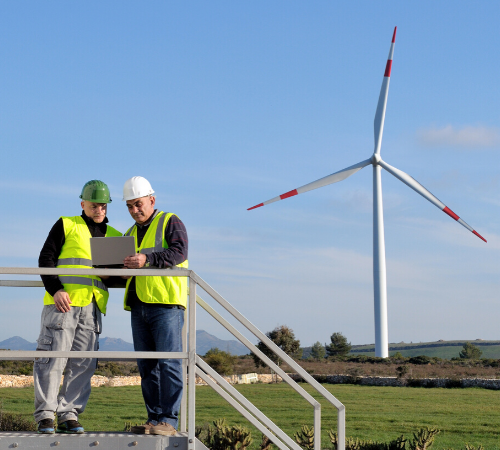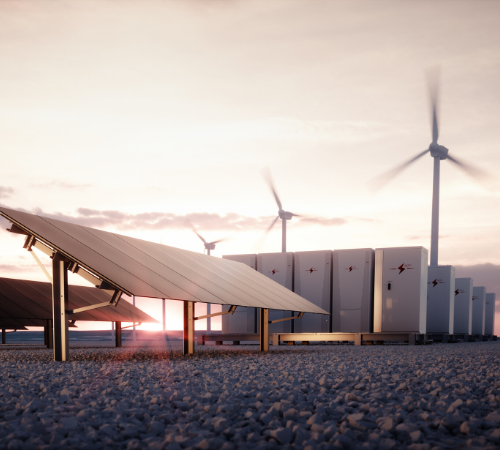Along with many other sectors, the energy industry is embracing ‘Industry 4.0’, or ‘The Fourth Industrial Revolution’. This means using automation and digitisation to optimise production within smart environments.
We can already see Energy 4.0 in action with the likes of smarter grids, renewable energy technology, and greater customer choice. In this blog, we’ll take a look at four interesting ways technology is going to continue to change the energy industry, and what these changes could mean for the customer.
The Internet of Things (IoT) refers to the connection of everyday objects via the internet, which allows them to send and receive data between each other (for example, connected appliances within a smart home). The Industrial Internet of Things (IIoT) works on a bigger scale, referring to the digital interconnection of devices within large industrial processes. Examples from the energy industry include connecting things such as drilling rigs, refineries, pipelines, and power grids.
IIoT sensors can harness data collected from out in the physical field, otherwise known as ‘The Edge’. For example, a wind turbine, at the very physical edge of the energy industry, can use multiple sensors to collect weather data. This real-time data can then be analysed in the cloud. Sensors can monitor changes in temperature, moisture and vibrations, predicting equipment failures and helping to keep people safe.
One interesting use of IIoT data from the Edge is the creation of ‘digital twins’. A digital twin is a model of the physical world that can be used to run simulations in order to gain data and insights. This works by using information gathered from the IIoT systems attached to its physical twin. Harnessing data from the Edge via the IIoT should lead to better detection of faults and smarter responses to energy demands, meaning customers can expect less downtime and better access to energy when they need it. In addition, the deployment of 5G in the energy sector will be a further boost to the IIoT.

Artificial Intelligence (AI) is predicted to transform many industries. It can help to turn vast amounts of data into actionable insights, in a way that would be impossible using manual methods. An example of how this could apply to the energy industry would be using AI to translate large amounts of geographical data (such as seismic logs and rock composition) to help geoscientists predict the best places to drill.
AI can also be used for predictive maintenance, which analyses data from machinery to predict when a piece of equipment is likely to fail or need repairing. This helps to take the guesswork out of maintenance, improving safety for workers as well as making energy production more efficient. In turn, predictive maintenance minimises unplanned outages for customers by ensuring ageing assets are replaced or retired at the most appropriate time.
Energy companies will be hoping that AI will be able to drive faster and sharper decision making. These findings can be visualised into simple interfaces and dashboards, making it easier for people of all technical abilities to take away actionable insights. AI-driven analysis can also be used to improve customer service and customer relationships.

How we store energy is a crucial aspect of the energy industry. The prices of batteries in general are falling and improvements in storage technology could be a major trend to watch out for over the coming years – especially in relation to renewable energy. Renewable energy technologies such as solar and wind are weather dependent, so we can’t always choose when they produce the most power. That makes it key to be able to store energy efficiently at the times when power is being generated. Battery storage combines well with renewable technology as excess energy can be saved and used in times of need.
Using new materials could make current battery technology more efficient. For example, the electrical conductivity of graphene is a thousand times better than copper, and it has a very high surface-area-to-volume ratio. These properties make it an extremely useful component to include in Lithium-ion batteries. Better battery storage technology will make it easier to balance customer supply and demand. Utility companies will be able to ride through peaks of high customer demand without taxing their generation facilities or increasing output.

Increased digitisation means the energy grid will need to employ solutions to prevent the risk of cyberattacks. As we saw in the first section of this blog, the IIoT means that many points of the energy industry are connected. This makes IIoT cyber incidents more serious than a conventional back-office IT breach, as entire processes, operations, and strategic assets can be affected.
Due to ever-increasing connectivity, multi-site and multi-region solutions will help to keep all of an energy company’s assets protected. AI and blockchain also look well placed to help protect against cyberattacks. Other options to defend against cybercrime include recruiting hacking experts to predict and manage cyberattacks, or putting end-to-end enterprise-wide detection and response systems in place.
Moving forward, cybersecurity should be a key consideration to protect systems and data – and never an afterthought. As energy companies enjoy the benefits that capturing and exploiting IIoT data can bring, they will also need to ensure they keep customers and their energy supplies safe.

Valda understand the importance of taking advantage of new technologies. That’s why we pride ourselves on being a digitally-focused supplier who use the best tools to help our customers, from smart metering to our user-friendly online portal.
Even though technology is disrupting the energy industry, we still believe that people are the key to a great customer experience. We create the best solutions for you and your business by combining the very latest technologies with the human touch. Trust us for user-friendly service and digital solutions that make things simple.